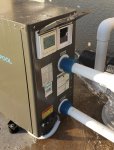A lady up the street from me bought a house in April but decided to open the valves to her Fibropool heat pump today for the first time. Both the in and the our unions to the heater sprayed water everywhere when she turned the pump on.
When I got there, unscrewed both unions and found what looks to be a very soft green gasket in each of the unions. She has an a/c repair company coming out next week to look at it.
Has anyone ever seen unions like this before?
When I got there, unscrewed both unions and found what looks to be a very soft green gasket in each of the unions. She has an a/c repair company coming out next week to look at it.
Has anyone ever seen unions like this before?



